Opisthoteuthis grimaldii
Roger Villanueva, Michael Vecchione, and Richard E. YoungIntroduction
This species reaches a maximum size of 50 mm ML. Its early description (1903) and the poor knowledge of cirrates in the first half of the 20th century resulted in reports of this species from many localities in the Atlantic and Indian Oceans. Most of these records were questioned by Villanueva et al. (2002) and they confirm identifications only from the Eastern Atlantic.
Characteristics
- Arms and suckers
- Arms subequal, about 366 - 380% of ML.
- Arm sucker count 73-80.
- Males with two fields of enlarged suckers present on all arms; largest sucker diameter of distal field less than that of proximal field.
- Proximal field with suckers 4-11 typically enlarged; suckers 6 or 7 usually largest; all arms with equal enlargement.
- Distal field with usually 9-10 suckers enlarged, typically lie between sucker numbers 21-40; suckers 29-31 usually largest; all arms with equal enlargement.
- Single web nodule present on ventral margin of each arm; nodule arises at level of sucker 25-30, just prior to the largest enlarged distal sucker.
- Cirri short; longest 2.5-4.7 mm or 5-10% of ML.
- First cirri appear between suckers 2 and 5.
 Click on an image to view larger version & data in a new window
Click on an image to view larger version & data in a new window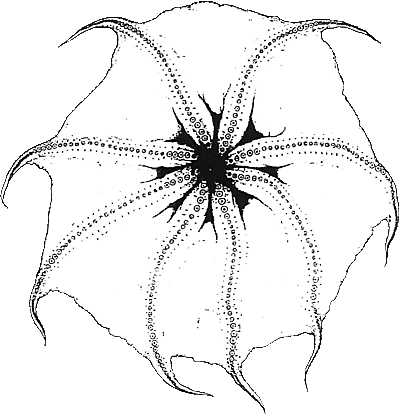
Figure. Oral view of O. grimaldii, mature male, 45 mm ML. Drawing from Villanueva et al., 2002.
Comments
The above description is taken from Villanueva et al.,2002. More details of the description of O. grimaldii can be found here.
O. grimaldii shares (where males are known) enlarged suckers in both proximal and distal fields that are the same on all arms with O. agassizii, O. bruuni, O. chathamensis and O. hardyi. It differs from from O. agassizii in having a bilobular digestive gland and single web supports, it differs from O. bruuni in the number of suckers in the distal field (9-10 vs 2-3), it differs from O. chathamensis in the number of suckers on each arm (73-80 vs 41-45), and it differs from O. hardyi in having a bilobular digestive gland and web supports.
Distribution
Type locality: Azores Islands, 55 miles NW of Fayal, 1900 m. Positive records are known only from the Eastern Atlantic from off Nambia (24° 5'S) to the Rockall Trough (ca. 55° N) at depths of 1135-2287 m (Villanueva et al. (2002).
References
Villanueva, R., Collins, M., Sanchez, P. and N. Voss. 2002. Systematics, distribution and biology of the cirrate octopods of the genus Opisthoteuthis (Mollusca, Cephalopoda) in the Atlantic Ocean, with description of two new species. Bulletin of Marine Science 71(2):933-985.
Title Illustrations

| Scientific Name | Opisthoteuthis grimaldii |
|---|---|
| Reference | Joubin, L. 1920. Cephalopodes provenant des Campagnes de la Princesse Alice (1898-1910). 3e Serie. Monaco. |
| Specimen Condition | Dead Specimen |
| View | Ventral |
| Type | Holotype |
| Scientific Name | Opisthoteuthis grimaldii |
|---|---|
| Reference | Joubin, L. 1920. Cephalopodes provenant des Campagnes de la Princesse Alice (1898-1910). 3e Serie. Monaco. |
| Specimen Condition | Dead Specimen |
| View | Dorsal |
| Type | Holotype |
| Scientific Name | Opisthoteuthis grimaldii |
|---|---|
| Reference | Villanueva, R., Collins, M., Sanchez, P. and N. Voss. 2002. Systematics, distribution and biology of the cirrate octopods of the genus Opisthoteuthis (Mollusca, Cephalopoda) in the Atlantic Ocean, with description of two new species. Bulletin of Marine Science 71(2):933-985. |
| Sex | Male |
| Life Cycle Stage | Mature |
| View | Ventral and dorsal |
| Size | 45 mm ML |
| Copyright | © 2002 Bulletin of Marine Science |
About This Page
Drawings of Villanueva et al. (2002) printed with the Permission of the Bulletin of Marine Science.
Roger Villanueva

Instituto de Ciencias del Mar (CSIC), Barcelona, Spain
Michael Vecchione

National Museum of Natural History, Washington, D. C. , USA
Richard E. Young

University of Hawaii, Honolulu, HI, USA
Page copyright © 2016 Roger Villanueva , Michael Vecchione , and Richard E. Young
All Rights Reserved.
- First online 13 May 2003
Citing this page:
Villanueva, Roger, Michael Vecchione, and Richard E. Young. 2003. Opisthoteuthis grimaldii . Version 13 May 2003 (under construction). http://tolweb.org/Opisthoteuthis_grimaldii/20159/2003.05.13 in The Tree of Life Web Project, http://tolweb.org/




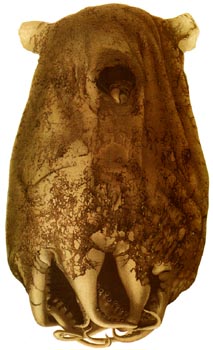
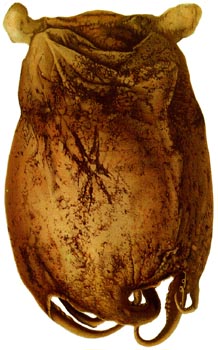
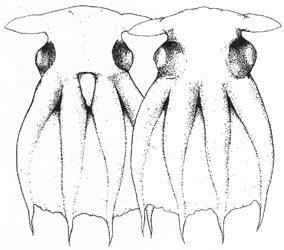



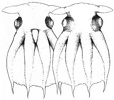


 Go to quick links
Go to quick search
Go to navigation for this section of the ToL site
Go to detailed links for the ToL site
Go to quick links
Go to quick search
Go to navigation for this section of the ToL site
Go to detailed links for the ToL site